As we’ve mentioned before, today marks the day that perhaps the biggest trial in patent law history begins. There will no doubt be weeks – if not months – of court proceedings to settle this matter, and it all began in earnest this morning. Apple and Samsung attempted to reach a settlement last week, but the companies could not reach an agreement, and the court case will go forward after all.
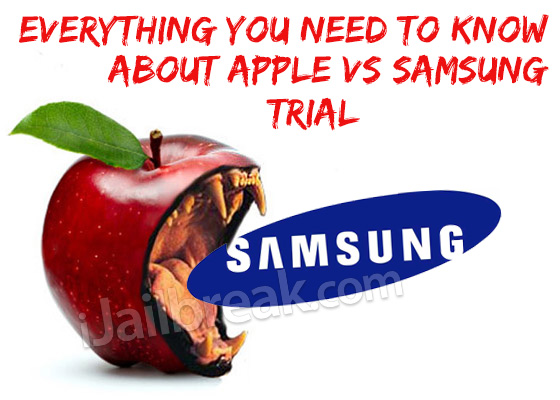
There’s a lot going on in this case, and there’s a lot at stake, both for Apple and Samsung, and for electronics-buying consumers. There’s also huge potential ramifications for inventors and other patent holders, since this case could have a pretty big effect on how broad patents are allowed to be, and how software patents are dealt with in court.
Given how big of a deal this, we thought it would be a good idea to give you all a rundown of exactly what’s going on here. What Apple wants, what Samsung wants, what devices are under fire, and what patents are allegedly being infringed. Let’s begin with the basic arguments from both companies; this is the respective narratives that both companies will be trying to establish in the eyes of the judge and jurors.
Apple’s Argument
Apple is essentially the aggressor in this case, and will be trying to argue that Samsung has willfully chosen to “compete unfairly” by copying Apple’s smartphones and tablets, instead of innovating themselves. The narrative will go that Samsung saw the designs of the iPhone and iPad, saw that they were wildly successful, and decided to make a very similar device so they could compete without inventing anything themselves.
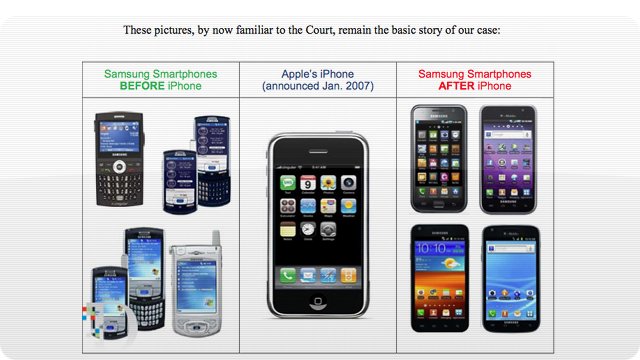
This essentially sums up why Apple is attacking Samsung in court
No doubt Apple will highlight the visual similarities between modern Samsung phones and the iPhone, and may even trot out something similar to that image we saw last week. They’ll also be trying to prove that the Galaxy Tab is a copy of the iPad, in a very similar manner.
Samsung’s Argument
Samsung will be mostly on the defensive, and their defense against Apple’s claims of wholesale copying will be along the lines of what we saw in that trial brief from last Thursday. Basically, Samsung will argue that Apple themselves are inventing things on the shoulders of decades of mobile phone development – some of which was done by Samsung themselves – that was done before Apple even entered the smartphone market. The idea being that while Samsung’s smartphones might visually resemble the iPhone, the iPhone already visually resembles earlier devices (like that Sony one from the trial brief), and that that’s just how forward progress works: you take that others have done successfully and improve on it.
They’ll also argue that Apple’s patents are far too broad, and litigating based on those patents is anti-competitive. Samsung will highlight the fact that Apple has chosen to try to shut down their competitors in court, rather than compete with them fairly in an open marketplace.
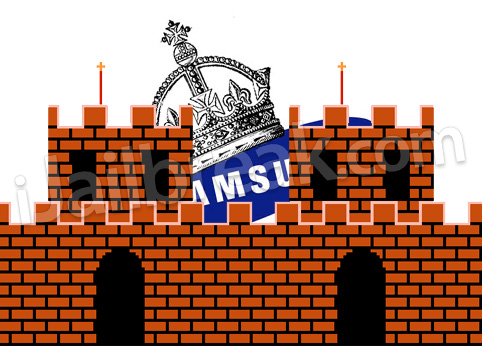
The Patents
Originally, there were dozens of patents and trade dress registrations on the table in this case, but at the behest of Judge Lucy Koh, that list has been pared down significantly. What now remains are four design patents, three utility patents, and Apple’s trade dress claims. The patents involved are as follows:
Utility patents:
- US Patent 7,469,381: This is the “rubber-banding” patent, that lets iOS users scroll past the edge of the screen, see some blank space, and have the screen snap back to the proper alignment.
- US Patent 7,844,915: This one seems to cover a facet of multitouch, wherein the device can detect whether you’re trying to scroll with one finger, or zoom with two fingers.
- US Patent 7,864,163: This covers the ability to tap on the screen to zoom, when there’s multiple content areas on-screen.
Design patents:
- US Patent D618,677: Basically a super broad patent on the “ornamental design” of the original iPhone. It covers the edge-to-edge front glass, the lack of buttons, etc.
- US Patent D593,087: This one’s an iPhone design patent, too. It covers the singular home button, the rounded corners, etc.
- US Patent D604,305: This covers the grid layout of icons on the iOS main menu, with the pinned row of icons at the bottom.
- US Patent D504,889: Another super broad patent here, this time for the design of a tablet. Edge-to-edge glass, minimalist design, rounded corners, etc.
Trade dress:
If you’re unfamiliar with trade dress, it’s basically the distinctive aesthetic of a brand, that tells consumers who’s product it is without the need of a logo. Usually these sorts of design traits are too vague to fall under a design patent, so they remain in the somewhat nebulous space of “trade dress.” For an example of trade dress, look at the front of any BMW made in the last few decades. Notice how the font grill is always split in the middle, and both sides have vertical black slats with a chrome lip around the perimeter? That’s trade dress.
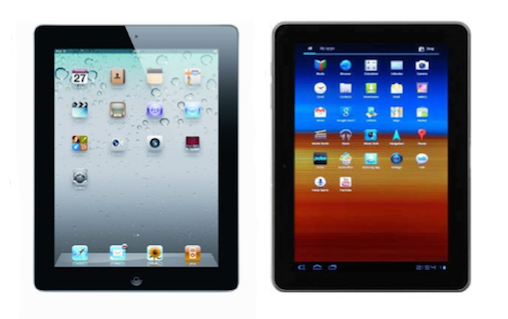
Apple will be contending that some of the features of current Galaxy smartphones and tablets are infringing on Apple’s trade dress, which might include the rounded edges, minimalist design and glossy black finishes.
The Devices
Apple will be targeting virtually every Samsung device released since the beginning of 2008, when the original iPhone was unveiled. There’s around 25 devices included in total, though super recent devices like the Galaxy Tab 2 and S III have escaped this round of litigation, since the case was filed before they existed. Apple will be required to prove every single one of these devices is infringing, on a device-by-device basis. They’ll have their work cut out for them.
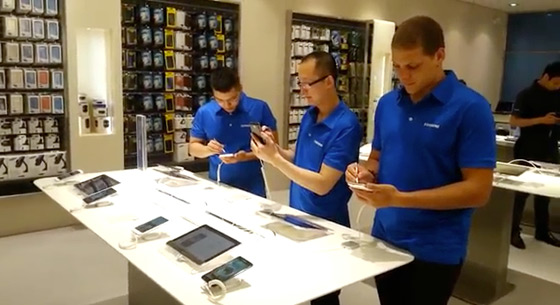
Is this an Apple store or a Samsung store?
Samsung, on the other hand, only has to address two devices with their counterarguments: the iPhone and the iPad. This will allow them to simplify their arguments and focus on their desired narrative.
What’s At Stake?
According to Apple, they’re owed $2.5 billion for Samsung’s rampant patent infringement. Samsung disagrees, and offered a hilariously low settlement of $28,452. If Apple is victorious, the actual amount Samsung has to pay will fall somewhere in between those two numbers. The more patents they’re found guilty of infringing on, and the more devices doing the infringing, the more money Apple is likely to be awarded.
Perhaps more importantly, though, what’s really at stake is the applicability of patents themselves. This case will set a strong precedent one way or the other, on whether incredibly broad patents like the ones Apple is using in this case should be granted in the first place. The question of whether something as simple as “a smartphone with nothing but a big screen on the front” should be eligible for a patent in the first place may be answered once and for all.
As consumers, we’d probably be better off if Apple lost this one. The broadness of their patents, and their haste to sue competitors who infringe on them, is making it very hard for other companies to innovate. It’s hard to innovate by improving current industry standard designs when a single company claims to have the patents on those industry standard designs.
If we’re being optimistic, we might say that this case has the potential to reel back some of the rampant silliness of the current American patent system. Whichever way the cookie crumbles, we’ll be keeping our eyes on these proceedings, and we’ll keep you updated.
See, I have been so disgusted with the new Androids that have been coming out recently because of how much of a rip-off they are to iPhones. The problem with this suit is that Apple SHOULD win this suit, and the only way how Samsung will win is to rely on their lawyers who did a pretty good job avoiding such copyright infringements while making it a similar as possible. Yes, Samsung is the main manufacturer for most Apple parts, so it may hinder the quality of the parts that we are getting in the future IF Apple wins. What is also a positive for having Samsung around, is that the competition really drives Apple and Sir Jon Ive to design the most beautiful devices. So morally, Apple should win, but it will affect us more negatively then positively. IF Samsung DOES win, then Apple will look like a fool to those who don’t know the truth like we geeks do, and Samsung will look as if they were the ones who were the “bigger person (company)”; throwing Apple a freebie.
So both ways, Apple will suffer. But it is also good that Apple addressed these things in public, and I am pretty sure that Samsung is going to be a lot more careful at the new device designs that are rolled out in following years, no matter what the outcome is. Though it is Apple’s fault for bringing these issues up, and looking stupid…
Ouch.